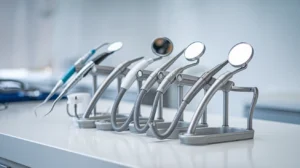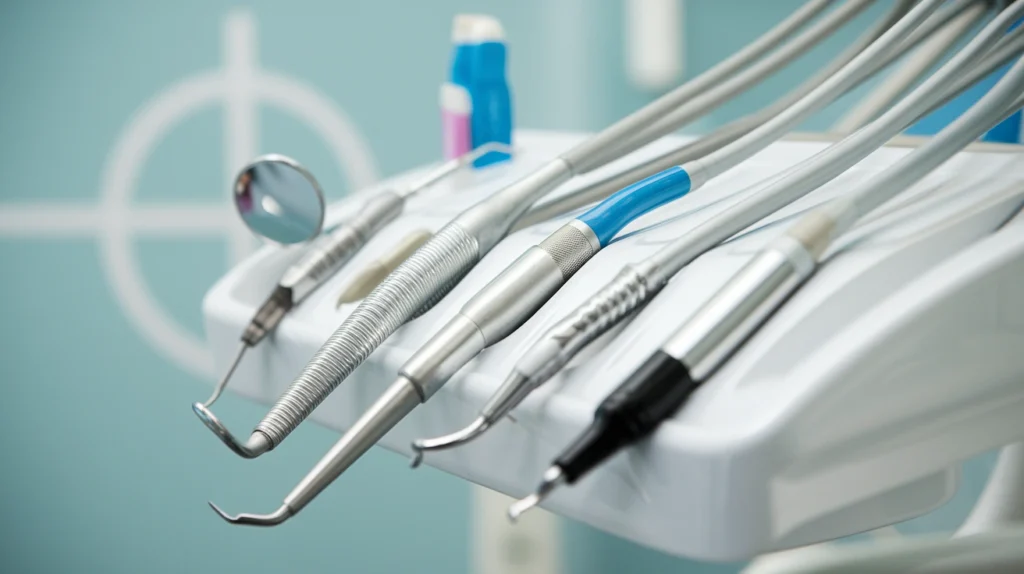
How to Choose the Best Dental Mouth Mirror for Oral Care
Picking the right dental mouth mirror might seem like a small task, but it’s actually pretty important for keeping your teeth and gums healthy. With so many options out there,

Alright, let’s talk about this nifty tool called the amalgam carrier. If you’ve ever been curious about what goes on behind the scenes in dental procedures, this is your chance to get the scoop. Amalgam carriers are like the unsung heroes in restorative dentistry, making sure everything runs smoothly when it comes to filling cavities. They’re designed to carry and place amalgam, that silver-colored stuff dentists use to fill teeth. In this guide, we’re breaking it all down so you can understand the different types, how they work, and why they’re super important in dental care. Whether you’re a dental student, a professional, or just someone curious about dental tools, this article will give you a clear picture of amalgam carrier uses.
Key Takeaways
Introduction to Amalgam Carriers
When you think about dental tools, amalgam carriers might not be the first thing that pops into your head. But in the world of dentistry, they play a pretty crucial role. These little instruments are all about precision and efficiency, helping dentists deliver the right amount of amalgam to a tooth cavity.
Amalgam carriers are designed to transport and deposit dental amalgam into the prepared tooth cavity. They come in different shapes and sizes, but they all serve the same basic purpose. Without them, the process of filling a cavity would be a lot more cumbersome and less accurate.
Here’s a quick overview of what makes these tools tick:
In a nutshell, amalgam carriers are the unsung heroes of dental procedures. They ensure that the amalgam is placed precisely where it’s needed, making the dentist’s job a whole lot easier and the patient’s experience a lot smoother.
Understanding the role of these carriers gives you a glimpse into the meticulous nature of dental work. It’s all about getting the details right, and these tools help make that possible.
An amalgam carrier is a vital tool in dentistry, designed to transport and place amalgam—a common dental filling material—into prepared cavities in teeth. Without it, the precise placement of amalgam would be challenging, if not impossible. This simple yet essential instrument allows dentists to deliver the right amount of amalgam directly into the cavity, ensuring a smooth and efficient dental procedure.
Key Features of Amalgam Carriers

Usage in Dental Procedures
Amalgam carriers are primarily used in restorative dentistry, particularly for:
The amalgam carrier is not just a tool; it’s an extension of the dentist’s hand, allowing for meticulous and efficient dental care. Its role in modern dentistry underscores the importance of precision instruments in achieving optimal patient outcomes.
In conclusion, understanding the function and importance of an amalgam carrier is key for anyone involved in dental care, from seasoned professionals to dental students. Whether you’re looking to invest in a high-quality amalgam carrier or simply seeking to understand its role, appreciating its value is essential for effective dental practice.
When it comes to dental procedures, having the right tools can make all the difference. Among these tools, amalgam carriers stand out for their role in transporting and placing dental amalgam. They come in two main varieties, each suited to different needs in the dental world.
Single-ended Amalgam Carriers
Single-ended amalgam carriers are the straightforward workhorses of dental tools. They feature a single barrel or scoop, perfect for transferring amalgam from the mixing area to the prepared cavity. These carriers are often favored for their simplicity and ease of use. With a single end, they offer precision in handling smaller amounts of amalgam, making them ideal for straightforward procedures where less material is needed. They’re particularly useful in situations where space is limited and maneuverability is key.
Double-ended Amalgam Carriers
Double-ended carriers, on the other hand, are designed for versatility. They come equipped with two ends, usually of differing sizes, allowing dentists to choose the appropriate end based on the size and depth of the cavity. This dual functionality makes them highly adaptable, especially in more complex restorative procedures. The ability to switch between ends without changing tools can save time and streamline the process, enhancing efficiency in the dental practice.
In the ever-evolving field of dentistry, choosing between a single or double-ended amalgam carrier often depends on the specific needs of the procedure and the preference of the dental professional. Each type brings its own set of advantages, ensuring that dental amalgam is applied effectively and efficiently.
Amalgam carriers are essential tools in dental procedures, specifically designed for transporting and placing amalgam into prepared cavities. Understanding their operation is crucial for effective dental restorations.
Loading the Amalgam Carrier
The process begins with loading the amalgam carrier. After trituration, the amalgam is placed in a metal well. The carrier is pressed into the amalgam, picking up small, manageable portions. It’s important to ensure the carrier is filled but not overfilled to prevent spillage or waste.
Placing Amalgam into the Cavity
Once loaded, the amalgam is transported to the prepared cavity. The carrier allows for precise placement, typically starting at the deepest part of the cavity, known as the box. This ensures that the amalgam is properly seated and ready for condensation.
Condensation and Finishing
Condensation follows placement, where a condenser is used to compact the amalgam into the cavity. This process requires applying pressure to eliminate voids and ensure complete adaptation to cavity walls. It’s essential to overfill slightly to allow for carving and shaping later.
Proper use of amalgam carriers ensures that the amalgam is placed efficiently and effectively, minimizing waste and maximizing the quality of the dental restoration.
In summary, the amalgam carrier is a simple yet vital tool in dentistry, enabling precise and efficient placement of amalgam, thus playing a key role in successful restorations. For more on how angled amalgam carriers are utilized, especially in complex dental procedures, see our detailed guide.
Dental Procedures
Amalgam carriers are vital in dental procedures, especially when dealing with silver amalgam fillings. These tools transport the amalgam material from the mixing area to the prepared tooth cavity. This ensures that the amalgam is delivered efficiently and accurately, minimizing waste and ensuring the cavity is completely filled. Dentists rely on these carriers for precision, as the right amount of amalgam must be placed without delay, ensuring the material doesn’t harden prematurely.
Restorative Dentistry
In restorative dentistry, amalgam carriers play a crucial role. They are used to restore the function and integrity of missing tooth structure, which can result from decay or external trauma. The carrier ensures that the amalgam is packed tightly into the cavity, reducing the risk of voids that could compromise the restoration. This tool is especially useful in cases where the restoration involves multiple surfaces or when the cavity is located in a hard-to-reach area of the mouth.
Proper use of amalgam carriers can significantly enhance the longevity and effectiveness of dental restorations, making them indispensable in modern dentistry.

Amalgam carriers are essential tools in dental practices, offering several benefits that make them indispensable. Their primary advantage lies in their ability to deliver amalgam efficiently and precisely to the prepared cavity. This ensures that the dental restoration process is both effective and smooth.
Key Advantages:
Enhanced Patient Outcomes:
Cost-Effectiveness:
Amalgam carriers, being durable and reusable, represent a cost-effective solution for dental practices. Their longevity and reliability mean fewer replacements and repairs, making them a smart investment for dentists.
Using amalgam carriers not only improves the quality of dental restorations but also enhances the overall efficiency of dental procedures, benefiting both practitioners and patients alike.
These tools, with their straightforward design and functionality, continue to play a crucial role in restorative dentistry, ensuring that procedures are carried out with precision and care.
Taking care of your amalgam carrier is key to ensuring its longevity and performance. These tools are vital in dental procedures, so keeping them in top shape is important. Here’s how you can maintain them:
Keeping your amalgam carrier in good condition not only extends its life but also ensures that every procedure goes smoothly. A well-maintained tool is a reliable tool, making your work more efficient and effective.
By following these steps, you can keep your amalgam carriers in excellent condition, ready for any dental procedure.
Wrapping up our exploration of amalgam carriers, it’s clear they play a vital role in dental practices. These tools, essential for handling amalgam, ensure that dental restorations are done smoothly and effectively. Amalgam carriers streamline dental procedures, making the process more efficient for both the dentist and the patient.
In summary, amalgam carriers are indispensable in:
The use of amalgam carriers has stood the test of time, proving their worth in modern dentistry. As we continue to advance in dental technology, these tools remain a cornerstone in restorative procedures.
For those interested in the durability of amalgam restorations, it’s worth noting that the design of the cavity can significantly impact the outcome. Understanding these nuances helps in achieving better results and longer-lasting dental work.
Wrapping up our exploration of amalgam carriers, it’s clear that these tools are essential in dental procedures, especially when dealing with amalgam restorations. Whether you’re a seasoned dentist or just starting out, understanding the nuances of using an amalgam carrier can make a big difference in the quality of your work. From loading the carrier to placing the amalgam precisely, each step is crucial for a successful restoration. While the use of amalgam is declining due to the rise of tooth-colored alternatives, its reliability in certain situations can’t be overlooked. So, whether you’re sticking with traditional methods or exploring new ones, having a solid grasp of amalgam carrier techniques will always be a valuable skill in your dental toolkit.
An amalgam carrier is a dental tool used to transport and place amalgam into a tooth cavity during dental procedures.
To use an amalgam carrier, fill it with amalgam, then carefully place the amalgam into the prepared tooth cavity. Press the lever to release the amalgam where needed.
There are single-ended and double-ended amalgam carriers. Single-ended carriers have one working end, while double-ended carriers have two ends for different sizes of amalgam.
Maintaining amalgam carriers ensures they remain clean and functional, preventing contamination and ensuring precise placement of amalgam.
Amalgam carriers are specifically designed for amalgam, but some may be adaptable for other dental materials if needed.
If amalgam sticks to the carrier, ensure the tool is clean and dry before use. You can also lightly tap the carrier to release any stuck amalgam.

Picking the right dental mouth mirror might seem like a small task, but it’s actually pretty important for keeping your teeth and gums healthy. With so many options out there,

Dental mirrors have come a long way. From simple reflective tools to sophisticated gadgets, they play a key role in modern dentistry. With constant innovation in dental mirrors, these aren’t

Hey there, dental pros! Today, we’re diving into something super important but often overlooked—how to properly mouth mirror sterilization. If you’re in the dental field, you know these little tools
At The Surgical Kit, we are committed to providing healthcare professionals with the finest tools to ensure precision and safety in every procedure.